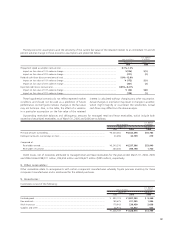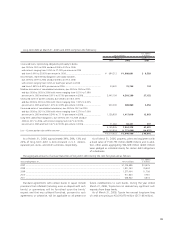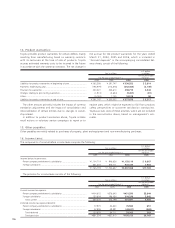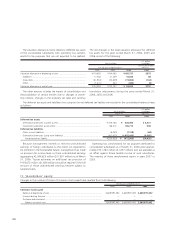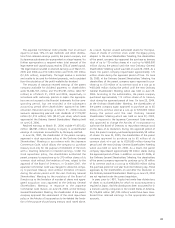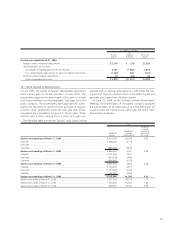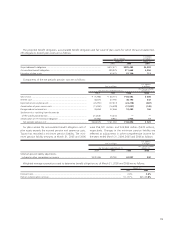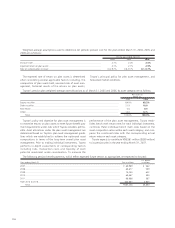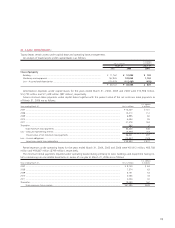Toyota 2006 Annual Report Download - page 111
Download and view the complete annual report
Please find page 111 of the 2006 Toyota annual report below. You can navigate through the pages in the report by either clicking on the pages listed below, or by using the keyword search tool below to find specific information within the annual report.109
The Japanese Commercial Code provides that an amount
equal to at least 10% of cash dividends and other distribu-
tions from retained earnings paid by the parent company and
its Japanese subsidiaries be appropriated as a legal reserve. No
further appropriation is required when total amount of the
legal reserve and capital surplus reaches 25% of stated capital.
The legal reserve included in retained earnings as of March 31,
2005 and 2006 was ¥141,064 million and ¥145,103 million
($1,235 million), respectively. The legal reserve is restricted
and unable to be used for dividend payments, and is excluded
from the calculation of the profit available for dividend.
The amounts of statutory retained earnings of the parent
company available for dividend payments to shareholders
were ¥4,864,555 million and ¥5,255,265 million ($44,737
million) as of March 31, 2005 and 2006, respectively. In
accordance with customary practice in Japan, the appropria-
tions are not accrued in the financial statements for the corre-
sponding period, but are recorded in the subsequent
accounting period after shareholders’ approval has been
obtained. Retained earnings at March 31, 2006 include
amounts representing year-end cash dividends of ¥178,297
million ($1,518 million), ¥55 ($0.47) per share, which were
approved at the Ordinary General Shareholders’ Meeting held
on June 23, 2006.
Retained earnings at March 31, 2006 include ¥1,055,422
million ($8,985 million) relating to equity in undistributed
earnings of companies accounted for by the equity method.
In June 26, 1997, the shareholders of the parent company
approved a stock repurchase policy at the Ordinary General
Shareholders’ Meeting in accordance with the Japanese
Commercial Code, which allows the company to purchase
treasury stock only for the purpose of retirement of the stock
with a resulting reduction in retained earnings. Under the
stock repurchase policy, the shareholders authorized the
parent company to repurchase up to 370 million shares of its
common stock without the limitation of time, subject to the
approval of the Board of Directors. In October 2001, the
Japanese Commercial Code was changed to allow the compa-
ny to purchase treasury stock without limitation of reason
during the whole period until the next Ordinary General
Shareholders’ Meeting by the resolution of the Board of
Directors up to the limitation of number of shares and aggre-
gated acquisition costs approved at the Ordinary General
Shareholders’ Meeting. In response to the Japanese
Commercial Code revision, on June 26, 2002, at the Ordinary
General Shareholders’ Meeting, the shareholders of the parent
company approved the amendment of the stock repurchase
policy in the Articles of Incorporation to be deleted the limita-
tion of the purpose of purchasing treasury stock noted above.
As a result, Toyota’s unused authorized shares for the repur-
chase of shares of common stock under the legacy policy
elapsed. In the same Shareholders’ Meeting, the shareholders
of the parent company also approved the purchase as treasury
stock of up to 170 million shares at a cost up to ¥600,000
million during the period until the next Ordinary General
Shareholders’ Meeting which was held on June 26, 2003. As a
result, the parent company repurchased approximately 170
million shares during the approved period of time. On June
26, 2003, at the Ordinary General Shareholders’ Meeting, the
shareholders of the parent company again approved to pur-
chase up to 150 million of its common stock at a cost up to
¥400,000 million during the period until the next Ordinary
General Shareholders’ Meeting which was held on June 23,
2004. According to this authorization, the parent company
purchased approximately 113 million shares of its treasury
stock during the approved period of time. On June 23, 2004,
at the Ordinary Shareholders’ Meeting, the shareholders of
the parent company again approved to purchase up to 65
million of its common stock at a cost up to ¥250,000 million
during the period until the next Ordinary General
Shareholders’ Meeting which was held on June 23, 2005,
and, in response to the Japanese Commercial Code revision,
also approved to change the Articles of Incorporation to
authorize the Board of Directors to repurchase treasury stock
on the basis of its resolution. During this approved period of
time, the parent company purchased approximately 59 million
of shares. On June 23, 2005, the shareholders of the parent
company approved to purchase up to 65 million of its
common stock at a cost up to ¥250,000 million during the
period until the next Ordinary General Shareholders’ Meeting
which was held on June 23, 2006. As a result, the parent
company repurchased approximately 38 million shares during
the approved period of time. In addition, on June 23, 2006, at
the Ordinary General Shareholders’ Meeting, the shareholders
of the parent company approved to purchase up to 30 million
of its common stock at a cost up to ¥200,000 million during
the purchase period of one year from the following day. These
approvals by the shareholders on and after the resolution in
the Ordinary General Shareholders’ Meeting on June 23, 2004
are not required under the current regulation.
In years prior to 1997, Toyota had made free distributions
of shares to its shareholders for which no accounting entry is
required in Japan. Had the distributions been accounted for in
a manner used by companies in the United States of America,
¥2,576,606 million ($21,934 million) would have been trans-
ferred from retained earnings to the appropriate capital
accounts.




